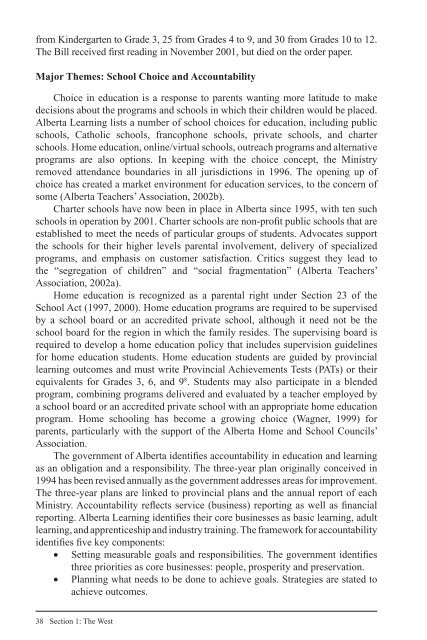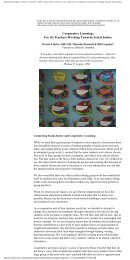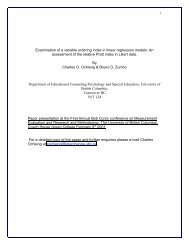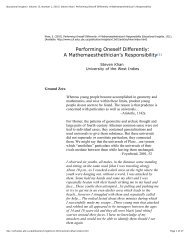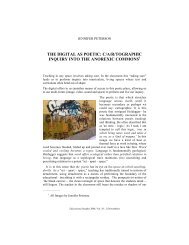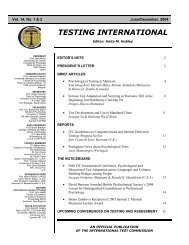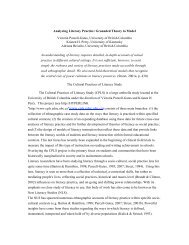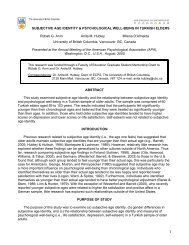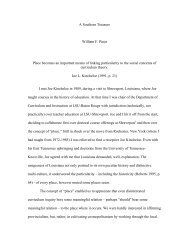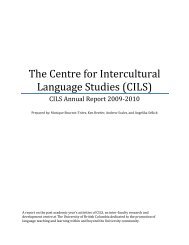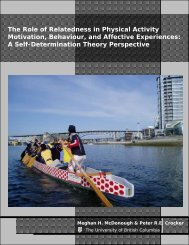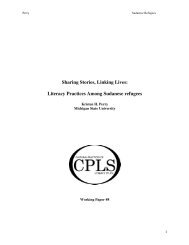The evolution of professionalism - Centre for Policy Studies in ...
The evolution of professionalism - Centre for Policy Studies in ...
The evolution of professionalism - Centre for Policy Studies in ...
Create successful ePaper yourself
Turn your PDF publications into a flip-book with our unique Google optimized e-Paper software.
from K<strong>in</strong>dergarten to Grade 3, 25 from Grades 4 to 9, and 30 from Grades 10 to 12.<br />
<strong>The</strong> Bill received fi rst read<strong>in</strong>g <strong>in</strong> November 2001, but died on the order paper.<br />
Major <strong>The</strong>mes: School Choice and Accountability<br />
Choice <strong>in</strong> education is a response to parents want<strong>in</strong>g more latitude to make<br />
decisions about the programs and schools <strong>in</strong> which their children would be placed.<br />
Alberta Learn<strong>in</strong>g lists a number <strong>of</strong> school choices <strong>for</strong> education, <strong>in</strong>clud<strong>in</strong>g public<br />
schools, Catholic schools, francophone schools, private schools, and charter<br />
schools. Home education, onl<strong>in</strong>e/virtual schools, outreach programs and alternative<br />
programs are also options. In keep<strong>in</strong>g with the choice concept, the M<strong>in</strong>istry<br />
removed attendance boundaries <strong>in</strong> all jurisdictions <strong>in</strong> 1996. <strong>The</strong> open<strong>in</strong>g up <strong>of</strong><br />
choice has created a market environment <strong>for</strong> education services, to the concern <strong>of</strong><br />
some (Alberta Teachers’ Association, 2002b).<br />
Charter schools have now been <strong>in</strong> place <strong>in</strong> Alberta s<strong>in</strong>ce 1995, with ten such<br />
schools <strong>in</strong> operation by 2001. Charter schools are non-pr<strong>of</strong>i t public schools that are<br />
established to meet the needs <strong>of</strong> particular groups <strong>of</strong> students. Advocates support<br />
the schools <strong>for</strong> their higher levels parental <strong>in</strong>volvement, delivery <strong>of</strong> specialized<br />
programs, and emphasis on customer satisfaction. Critics suggest they lead to<br />
the “segregation <strong>of</strong> children” and “social fragmentation” (Alberta Teachers’<br />
Association, 2002a).<br />
Home education is recognized as a parental right under Section 23 <strong>of</strong> the<br />
School Act (1997, 2000). Home education programs are required to be supervised<br />
by a school board or an accredited private school, although it need not be the<br />
school board <strong>for</strong> the region <strong>in</strong> which the family resides. <strong>The</strong> supervis<strong>in</strong>g board is<br />
required to develop a home education policy that <strong>in</strong>cludes supervision guidel<strong>in</strong>es<br />
<strong>for</strong> home education students. Home education students are guided by prov<strong>in</strong>cial<br />
learn<strong>in</strong>g outcomes and must write Prov<strong>in</strong>cial Achievements Tests (PATs) or their<br />
equivalents <strong>for</strong> Grades 3, 6, and 9 8 . Students may also participate <strong>in</strong> a blended<br />
program, comb<strong>in</strong><strong>in</strong>g programs delivered and evaluated by a teacher employed by<br />
a school board or an accredited private school with an appropriate home education<br />
program. Home school<strong>in</strong>g has become a grow<strong>in</strong>g choice (Wagner, 1999) <strong>for</strong><br />
parents, particularly with the support <strong>of</strong> the Alberta Home and School Councils’<br />
Association.<br />
<strong>The</strong> government <strong>of</strong> Alberta identifi es accountability <strong>in</strong> education and learn<strong>in</strong>g<br />
as an obligation and a responsibility. <strong>The</strong> three-year plan orig<strong>in</strong>ally conceived <strong>in</strong><br />
1994 has been revised annually as the government addresses areas <strong>for</strong> improvement.<br />
<strong>The</strong> three-year plans are l<strong>in</strong>ked to prov<strong>in</strong>cial plans and the annual report <strong>of</strong> each<br />
M<strong>in</strong>istry. Accountability refl ects service (bus<strong>in</strong>ess) report<strong>in</strong>g as well as fi nancial<br />
report<strong>in</strong>g. Alberta Learn<strong>in</strong>g identifi es their core bus<strong>in</strong>esses as basic learn<strong>in</strong>g, adult<br />
learn<strong>in</strong>g, and apprenticeship and <strong>in</strong>dustry tra<strong>in</strong><strong>in</strong>g. <strong>The</strong> framework <strong>for</strong> accountability<br />
identifi es fi ve key components:<br />
• Sett<strong>in</strong>g measurable goals and responsibilities. <strong>The</strong> government identifi es<br />
three priorities as core bus<strong>in</strong>esses: people, prosperity and preservation.<br />
• Plann<strong>in</strong>g what needs to be done to achieve goals. Strategies are stated to<br />
achieve outcomes.<br />
38 Section 1: <strong>The</strong> West


